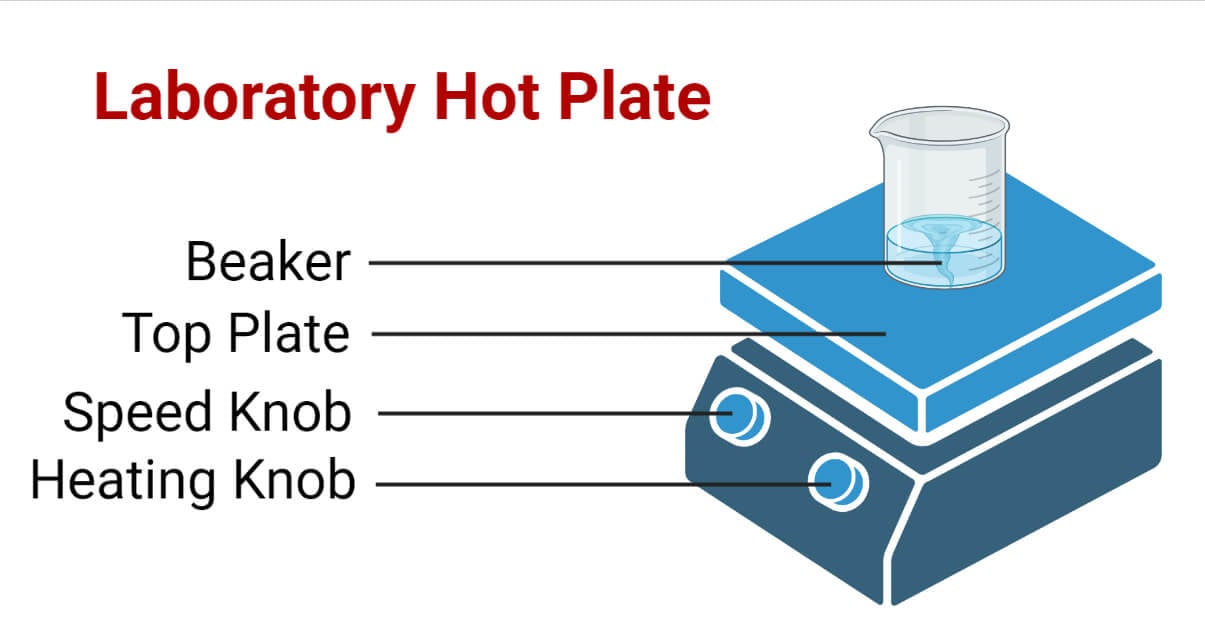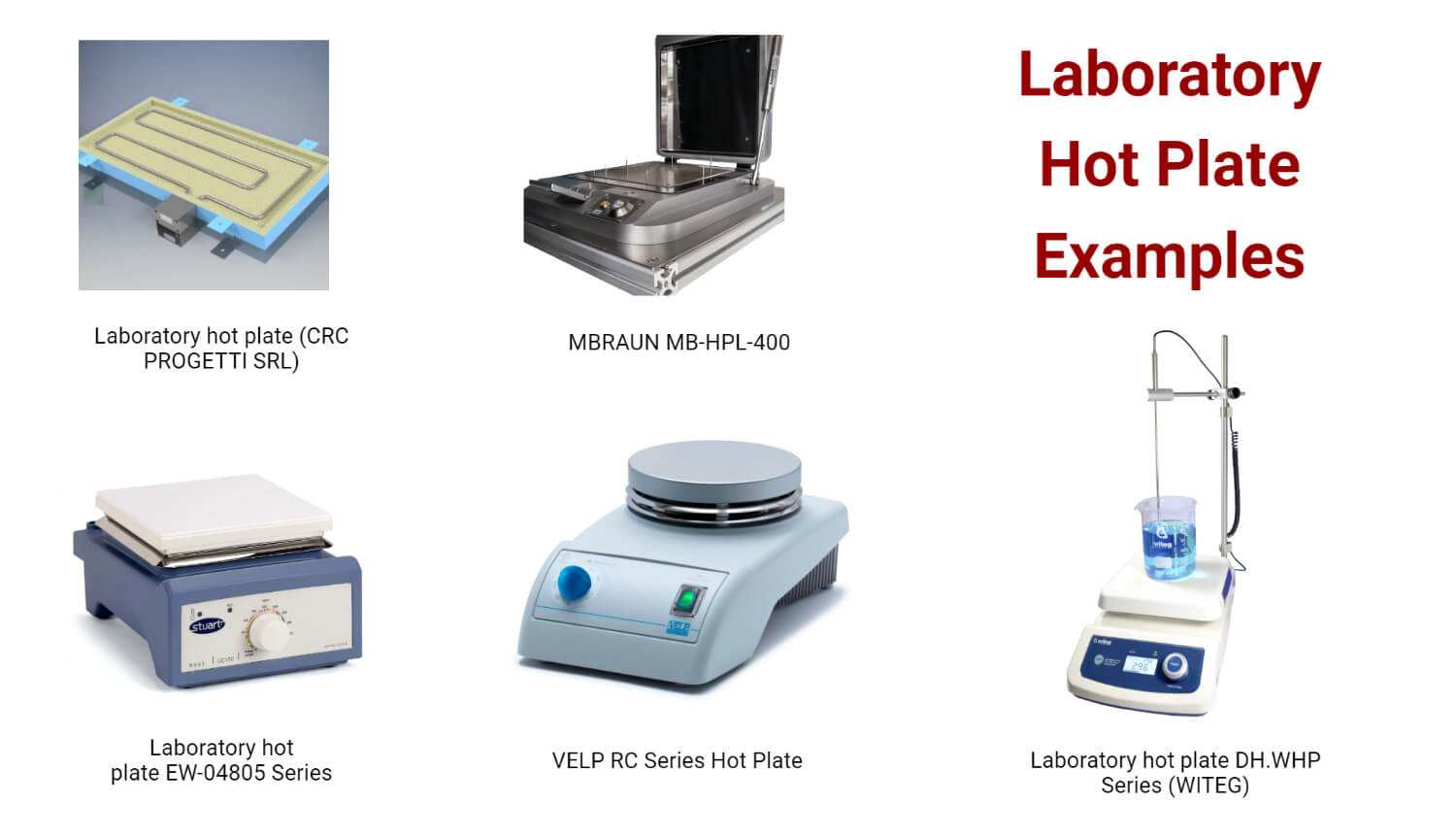A hot plate is a laboratory device used to heat samples, solutions, and materials uniformly without the danger associated with the open flame at precise temperatures.
Hot plates have a flat surface with heating sources. They are perfect for use in an oil or sand bath because they don’t emit open flames. It frequently works with a magnetic stirrer to maintain a consistent liquid temperature and provide optimum homogeneity.
Hotplates are extremely portable appliances with up to two gas burners. However, there are two different sizes of hotplates. The first is the larger single burner, while the second is the double burner. Additionally, two different kinds of burners can be used, and some burners can also function as an electric heating element. The primary benefit of a hot plate is that other than electricity, it has no special requirements for use. It is a device that is also simple to maintain and clean. Nevertheless, corrosion must be avoided at all costs.
The exterior layer is covered with stainless steel and other materials, a thermal conductivity plate, and it is based on the electric heating wire as a heating material to mica soft board and other materials as insulating material.
Interesting Science Videos
Principle of Hot Plate
The major component of the heating plate is electric alloy wire, and the electric effect is the only real functioning principle. Electric work involves a current flowing through an electric alloy wire that heats up and conducts heat through the outer shell. To prevent the user from experiencing hidden problems when the electric alloy wire is in use, the electric plate is constructed using an insulating material.
A hot plate stirrer normally operates based on a revolving electromagnetic field. There are several electromagnets implanted in the internal construction of hot plates. In the solution container, a magnetic bar—also referred to as a stir bar—is placed. The coating of the bar prevents it from reacting, making it chemically inert. A good submersion into the solution is necessary. On top of the hot plate is set the flask or beaker holding the solution together with the stir bar. Two adjustment knobs are present on the hot plate stirrer. The temperature of the apparatus can be changed using one of the knobs, and rotational speed can be altered with the other knob.
The electromagnets and heating mechanism are turned on when the hot plate stirrer’s main switch is flipped on. An electromagnetic field develops as a result of the solution being heated by the heating mechanism. As a result of the device’s electromagnetic field interfering with and interacting with the bar magnet’s static magnetic field, the solution rotates, gets mixed up properly, and heats up simultaneously. The container must be positioned in the center of the hot plate for efficient and even stirring.
Parts of Laboratory Hot Plate
Controls and Indicators
- Power indicator: When the hot plate is properly connected to input power, the power indicator illuminates continuously.
- Stir control knob: Turning the stir control knob completely counter-clockwise stops stirring. Appropriate stirring speed should be set by turning it clockwise.
- Stirring speed display: Displays the stirring speed that has been set.
- Heat control knob: The heat control knob should be turned completely counter-clockwise to turn off the heating system. The desired heating temperature can be set by turning it clockwise.

- Heating temperature display: Displays the temperature that has been set for heating.
- Hot top indicator: When the top is too hot to touch (hotter than 60°C), the indicator illuminates.
- Temperature probe in use indicator: When the unit is connected to an external temperature probe, the temperature probe in use indicator illuminates.
Connections
- Power cord input: Attach the power cord to this connector.
- External temperature controller input: The optional External Temperature Controller should be plugged into this connector.
Top plate
A hot plate appropriate for the materials to be heated should be selected. One should know how well the surface conducts heat and the maximum temperature it can withstand. The top plate can be constructed of aluminum, ceramic, or enamel.
Accessories
- Vertical support rod
- Holding rod
- External temperature controller
- Boss head clamp
- Thermometer holder
Procedure of using a Hot Plate
- Make sure the workspace is organized and spotless.
- Place the hot plate on a level, flat surface.
- Ensure that the instrument is clean and dust-free.
- Attach the power cord to the required power supply.
- Fill the solution to be heated in the vessel and place it on the plate and wait for heating.
- The heat light turns on when the heat control knob is turned clockwise.
- To set the desired heat setting, turn the heat control knob.
- Enter the beaker with the magnetic stirrer.
- Once the light is on, clockwise turn the stir control knob.
- To change the stirring speed to the preferred setting, turn the stir control knob.
- After finishing, switch the device off. Cut the supply’s power.
- Clean up the tool and work area.
Types of Hot Plates
Wafer hot plates and chemical hot plates are the two types of hot plates. Wafer hot plates have flat tops made of aluminium or anodized aluminium, while chemical hot plates have ceramic, enamel, or aluminium tops. Both the wafer hot plates and all new hot plates are explosion-proof. They are not capable of heating above 400C. Chemical hot plates can agitate and regulate temperature. A probe i.e., an external temperature controller implanted in the liquid, provides feedback to adjust the temperature.
There are three types of hot plates depending on the design.
Standard hot plate: This device has a heating system; there is no stirrer. It does, however, need fewer routines for maintenance and recalibration.
Hot plates with magnetic stirrer: This hot plate has a heating element and an embedded electromagnet. The magnetic bar submerged in the solution moves in a circular motion at a maximum speed of 2,500 rpm thanks to the electromagnet. You should know that the heating plate and magnetic stirrer cannot be used simultaneously.
Stirring hot plate: In this model, the heating and stirring components are set up beneath the machine’s flat top surface. Although it is typically the most expensive, it gives high-volume or viscous samples homogeneous heating.
Depending on the substance utilized to create a hot plate surface, they are of different kinds, namely:
Ceramic hot plates: They can endure temperatures of 350 °C. Although the tops are resistant to corrosion, they are susceptible to heat shock from metal cylinders. To heat glass beakers, they should be utilized.
Aluminium hot plates: Compared to other heating surfaces, aluminium hot plates’ tops offer superior heat uniformity and are tougher to shatter. High-throughput lab procedures can use the system.
Polypropylene hot plates: Unlike ceramic and aluminium plates, these plates cannot reach extremely high temperatures. They do, however, possess a high level of acid, solvent, and chemical resistance. These plates are used in scientific experiments with moist chemicals like acetonitrile, methanol, and ethanol.
Stainless steel hot plates: Hot plates made of stainless steel are very resistant to corrosion, ethers, and most alcohols. They support aseptic conditions and are appropriate for ISO-grade clean rooms, cGMP environments, and USP-compliant facilities.
Applications of Hot Plate
- Laboratory hot plates are used to warm up specimens for cytological, histological, and pathological investigations, as well as to warm up glassware or its contents generally.
- Hot plates are frequently used to prepare meals, usually in places where a full kitchen stove is not practical or handy.
- It is employed in fundamental studies on pain and testing the efficacy of analgesics by observing the response to heat-induced pain.
- In the mining and associated industries, hazardous chemical samples are heated on hot plates using special materials and protective coatings.
- Electronics manufacturers frequently solder and desolder components onto circuit boards using hot plates.
Precautions of using a Hot Plate
- Use caution if a spark is seen, the plug or cord is worn, frayed, or broken, or the grounding pin has been removed.
- Never store flammable substances or combustible materials next to the hot plate, and use older hot plates sparingly for flammable materials.
- Check the thermostat for corrosion, which can also result in a spark.
- Unplug devices while not in use.
- Use only borosilicate glassware that can withstand heat, and inspect it for cracks before heating.
- Never put jars, soft glass, or glass flasks directly on a hot plate.
- Make sure the plate’s surface is bigger than the item being heated.
- Never use a hot plate to heat foil or metal pans. Sparks and surface damage are both possible effects.
Advantages of Hot Plate
- Hot plates are relatively affordable.
- Hot plates are conveniently portable.
- They enable several vital laboratory processes.
- They are quite simple to use.
- Since they don’t employ any moveable mechanical parts, hot plate stirrers are less susceptible to wear and tear.
- Mechanical stirrers are being replaced with hot plate stirrers because they require less work, are quieter, and are considerably more effective.
Limitations of Hot Plate
Hot plates are frequently used in laboratories. However, they can be dangerous since they can produce burns, fires, and electrical shocks, which can result in accidents, seriously disrupt lab work, and destroy scientific data.
Examples of Hot Plate
Laboratory hot plate (CRC PROGETTI SRL)
- An extractable heater comprises a stainless-steel tube and an armored heating element.
- FIBRO-CERAMICO REFRATTARIO, a technological substance, is used for room insulation.
- Fully functional electrical PANELS with control and safety mechanisms (Thermocouples and programmable digital electronic instruments).
Laboratory hot plate MB-HPL-400 (Mbraun)
- Under specific process circumstances, the MBRAUN MB-HPL-400 Vacuum Hotplate is intended to cure delicate organic layers.
- Applications include everything from simple research to complex production procedures.

Laboratory hot plate EW-04805 Series (Stuart Equipment)
- The Stuart’s UC150 and US150 hotplates are made of either chemically resistant glass ceramic or coated aluminium silicon.
- These devices have integrated LED setting scales that display temperature measurements in degrees Celsius (°C), flashing “hot” warning indicators that flash when temperatures exceed 50 °C, and small overall designs.
Laboratory hot plate RC series (VELP Scientifica)
- Excellent chemical resistance, uniform heat distribution, coated aluminium alloy heating plate, and a maximum temperature of 370 °C.
- Holds flasks up to 15 liters in capacity.
Laboratory hot plate DH.WHP Series (WITEG Labortechnik GmbH)
- Two features—the closed coverage type and the intelligent fluid management system, which directs accidentally spilled liquids away from the device’s interior—protect the device against internal corrosion and extend its lifespan.
- Ideal for applications requiring high temperatures in the lab, such as sample drying and general heating.
References
- https://research.wayne.edu/oehs/pdf/factsheet-hot-plate.pdf
- https://chem.wisc.edu/wp-content/uploads/sites/1130/2019/12/HotPlateSafety.pdf
- https://neuationcentrifuges.wordpress.com/tag/what-is-hot-plate-used-for/
- J. Chem. Educ. 2018, 95, 11, 2050-2054
- https://www.laboratory-equipment.com/blog/hot-plate-comparison-for-digital-analog-magnetic-stirring-plates/#:~:text=Laboratory%20hot%20plates%20consist%20of,a%20digital%20or%20analog%20controller.
- https://lnf-wiki.eecs.umich.edu/wiki/Hot_Plate_Ettiquette
- https://www.nist.gov/system/files/documents/ncnr/Corning-Digital-Hot-Plate.pdf
- https://conductscience.com/laboratory-hot-plates/
- https://studiousguy.com/hot-plate-stirrer/
- https://www.directindustry.com/prod/crc-progetti-srl/product-214045-2479845.html
- https://www.directindustry.com/prod/mbraun/product-182696-2502266.html
- https://www.directindustry.com/prod/stuart-equipment/product-63431-694627.html
- https://www.directindustry.com/prod/velp-scientifica/product-15378-808937.html
- https://www.directindustry.com/prod/witeg-labortechnik-gmbh/product-104375-2228007.html
